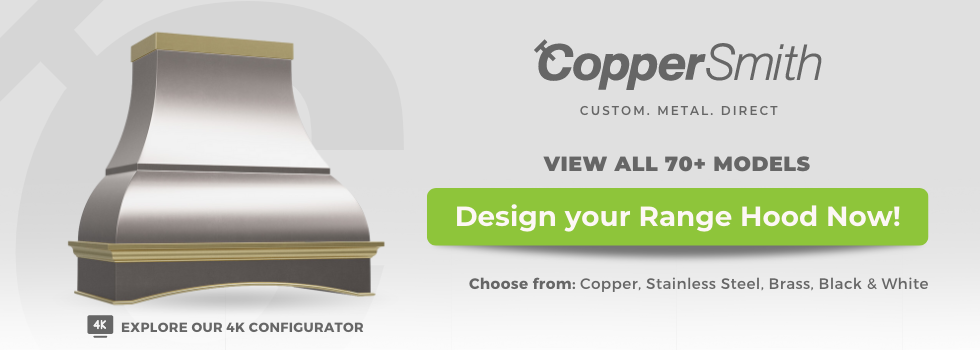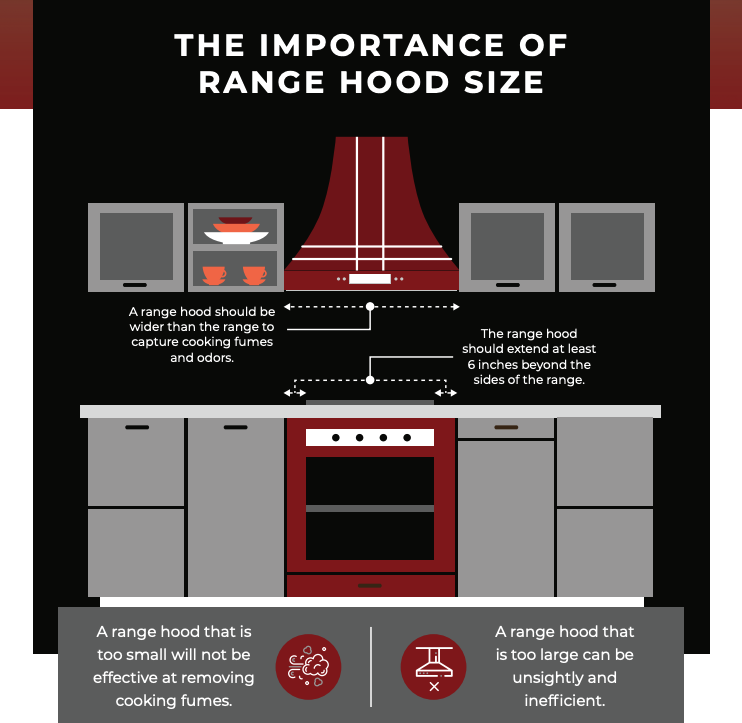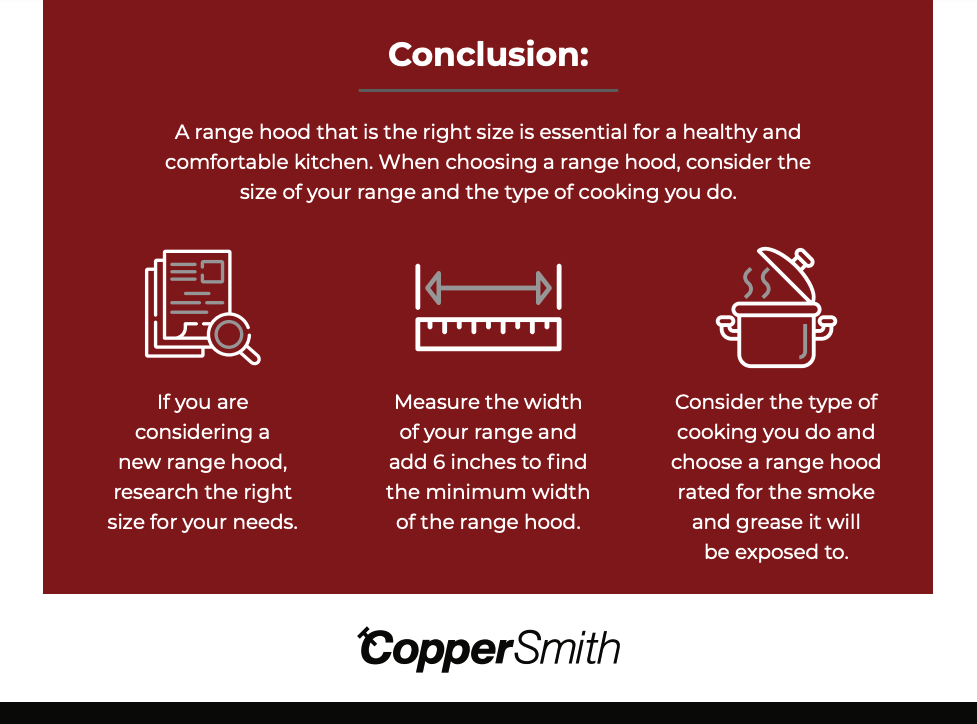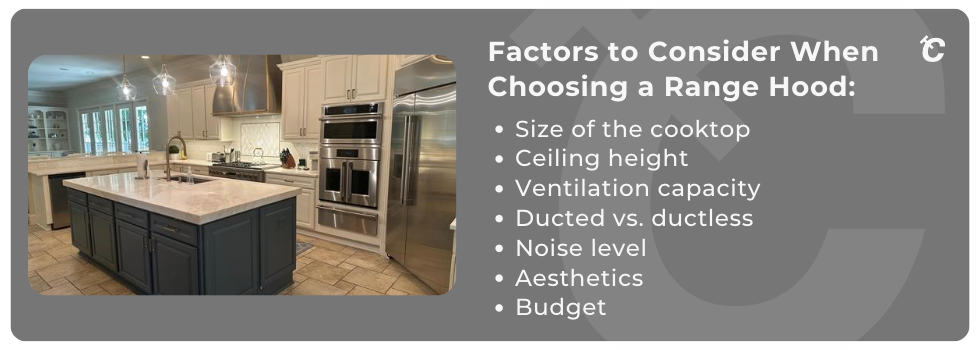
Range hoods are an often-underappreciated kitchen workhorse that helps keep our cooking surfaces clean and the air free from smoke and debris. They also help pull together the overall look of your cooking space, with many options available to match the particular aesthetic you're aiming for.
You've come to the right place if you're interested in a new range hood. We'll explain why vent hoods should be wider than your cooking surface and help you measure correctly for the perfect fit.

How Wide Should a Range Hood Be?
First, let’s address the core question: Should a range hood be wider than the range?
Your range hood should be six inches – three inches on each side– wider than your cooking surface to ensure maximum performance.
Because a range hood's primary function is to capture and remove smoke, grease, steam, and odors from your kitchen, anything smaller than that would allow all those contaminants to escape into the air.
It also looks more visually appealing, giving the area around your range a sense of balance, whereas a too-small hood can seem out of proportion.

Can a Hood Vent Be Smaller Than the Range?
A too-small range hood negatively impacts how efficiently the vent hood can funnel air–measured in cubic feet per minute (CFM)– and leads to messy walls and countertops because it can't capture debris across the entire cooking surface.
They also tend to wear out faster because the built-in motor has to work much harder and at higher speeds to vent the air.
In contrast, the right range hood can draw in the air much more efficiently, allowing it to operate at lower power while filtering at a higher CFM.
How Do You Measure for a New Vent Hood?

Before you settle on a new vent hood, you'll need to take a few measurements to ensure it will fit in the installation space.
However, different range hood styles require different dimensional considerations depending on where they're meant to fit into your kitchen.
Wall-Mounted Range Hoods
The most common range hood is the stainless steel, wall-mounted type. They are installed directly on the wall above the cooktop, allowing powerful fans and filtration systems to capture smoke, odors, and grease efficiently.
- Width: Measure the width of your range. Most standard ranges are 30 or 36 inches wide, but they can be as small as 24 inches and as large as 42 inches.
- Height: Measure the size of the space between the surface of the range's cooktop and the bottom of the upper cabinets or ceiling. Electric cooktops require a 20-inch minimum clearance, while gas-powered stoves need at least 24 inches.
- Ventilation: If your kitchen already has an existing duct system to vent the air outside, you'll need to figure out the exact configuration to ensure your range hood vent size is compatible.
- Chimney height: Chimney hoods have an adjustable stainless steel flue to ensure it is long enough to reach the necessary hookups. If you have exceptionally high ceilings, you'll need to find a model that accommodates your home's architecture.
Island Range Hoods
Island range hoods are designed to "float" above a cooktop built into a free-standing kitchen island. While most are stainless steel, they also come in decorative designs made from specialty materials, like glass and brass.
Rather than mounting to a wall or cabinetry, they require a suspension system from the ceiling. Therefore, you have more flexibility outside the standard range hood dimensions, but there are additional considerations for existing lighting.
- Width: Because an island range has open space on all four sides, it has access to more air than traditional cooktops, making it easier for contaminated air to escape into the rest of your home. Follow the three-inches rule on either side to accommodate the lack of contained space.
- Height: Measure from the top of the cooktop to the ceiling, keeping in mind the clearance rules: 24 to 36 inches away for gas ranges and 20 to 30 inches for electric.
- Ventilation: Many suspended range hoods are ductless, so you won’t have to worry about the ductwork or pay extra to install a new ventilation system.
Under-Cabinet Range Hoods
These space-saving stainless steel hoods install directly beneath the upper cabinets above the cooktop. Because of their low profiles, they offer a sleek, streamlined look ideal for smaller kitchens or those with limited cabinet space. Great for your range hood kitchen setting!
- Width: Like wall-mounted ranges, start by measuring the width of your range.
- Depth: Measure the depth of your upper cabinets. The range hood must be the same depth as the cabinetry and typically come in standard sizes of 12, 15, or 18 inches.
- Ventilation: Consider your existing ductwork or the possibility of installing new ducts. If you'd prefer to go ductless, some under-cabinet hoods use charcoal filters to clean and recirculate air back into your home.
Over-the-Range Microwave Hoods
Offering unmatched versatility, over-the-range microwave hoods save space by incorporating a stainless steel vent hood in this modern machine of culinary convenience.
However, they come with the additional consideration of being low enough to easily reach the microwave while still being high enough to meet safety standards.
Because the vent hood is built into the microwave, you would measure the same way as wall-mounted vents.
Range Hood Inserts
For kitchens with custom range hood shells, stainless steel range hood inserts include the blower, filter, and controls without an outer casing.
Many homeowners opt for this option when they have custom range hoods and want to upgrade the inner workings with modern advancements like temperature sensors or dimmer-controlled lighting.
Measuring for inserts differs from measuring for a complete system installation because, in most cases, the outer casing is already in place.
Instead, you'll need to focus on the dimensions of the shell, then subtract 2 inches to ensure a comfortable fit. That's why they come in off-standard sizes, like 28 and 34 inches.
So, for example, if you have a 30-inch range with a 36-inch vent hood, the insert should be 34 inches long and the same width as the cover.
Retractable Downdraft Range Hoods
Retractable downdraft range hoods– sometimes called telescoping hoods– are the ultimate solution for homeowners wanting to maintain a sleek, minimalist appearance while still having all the benefits a range hood offers.
Rather than mounting downdraft hoods to a wall or cabinets, these stainless steel wonders attach to the countertops, sitting flush with the surface when not in use. When you're ready to cook, you pull the vent hood to its full height.
They are an excellent alternative to suspended island hoods and often have touch-activated risers that make them effortless and efficient.
- Width: As always, start by measuring the width of your cooktop. However, a downdraft hood should be the exact width of the range rather than six inches wider.
- Depth: You must have enough room behind the cooktop to mount the unit to the countertop, so measure from the back of the range to the wall or counter edge.
- Height: Ensure enough clearance above the range to accommodate the fully-extended size, typically 14 to 18 inches.
What Are Standard Range Hood Dimensions?
To help you figure out which size range hood is appropriate for your needs, reference this list of standard dimensions while you’re measuring:
- Wall-Mounted Range Hood
- Standard widths: 30 to 36 inches
- Standard depths: 18 to 24 inches
- Standard heights: 18 to 30 inches, not including the adjustable chimney
- Island Range Hood
- Standard widths: 36 to 48 inches
- Standard depths: 24 to 27 inches
- Standard heights: 18 to 36 inches, not including the adjustable chimney
- Under-Cabinet Range Hood
- Standard widths: 24 to 42 inches
- Standard depths: 18 to 24 inches
- Standard heights: 6 to 18 inches
- Over-the-Range Microwave Hood
- Standard widths: 24 to 36 inches
- Standard depths: 15 to 18 inches
- Standard heights: 16 to 18 inches
- Range Hood Inserts for Custom-Built Shells
- Standard widths: 28 to 48 inches
- Standard depths: 18 to 22 inches
- Standard heights: 10 to 14 inches
- Retractable Downdraft Range Hoods
- Standard widths: 30 to 36 inches
- Standard depths: 5 to 4 inches
- Standard heights: 30 inches for the base unit, but extendable between 14 to 18.5 inches above the top of the cooking surface for a total of 44 to 48.5 inches
Factors to Consider When Choosing a Range Hood
With those dimensions in mind, here are some tips for what to consider before choosing a range hood:
- Size of the cooktop: As mentioned above, your range hood needs to be six inches wider than the cooking surface to optimize airflow.
- Ceiling height: If you’re considering an island or ceiling-mounted hood, you must be particular about the dimensions to ensure that the hood and chimney fit within the parameters for safe stovetop clearance.
- Ventilation capacity: A good rule of thumb for ventilation is that you’ll need at least 1 CFM per 100 BTUs for gas stoves and 1 CFM per square inch of electric cooktop surface area. For example, an 8,000 BTU gas range requires a range hood rated for at least 800 CFM. Similarly, a 30-inch by 21-inch electric stove would require 630 CFM.
- Ducted vs. ductless: A ducted range hood is more efficient at removing airborne particles but is often more complicated to install if you don’t have the existing ductwork to vent air outside. Ductless range hoods run air through a charcoal filter before recirculating it back into your home. They are less efficient but don’t require ductwork.
- Noise level: How much noise your range hood produces is measured in sones. Most range hoods fall between five to six sones or 51-54 dB. However, you can invest in quieter options that are only as loud as the hum of a running refrigerator or 1-2 sones.
- Aesthetics: As one of the largest appliances in your kitchen, your hood range should serve as a centerpiece and help bring the room together. Unfortunately, stainless steel options available in big box stores don’t have much to offer in appearance. Instead, invest in something that delights you every time you enter the room, like these beautiful white range hoods from CopperSmith.
- Budget: Like with any renovation project, the budget will play a role in your final selection for your range hood. Remember that you get what you pay for. It’s worth spending a bit extra on an efficient and effective appliance that will last you for years instead of the cheaper option that breaks down or leaves your home filled with smoke.
FAQs
If you're still wondering, “Should a range hood be wider than my cooktop,” we address some of the most commonly asked questions below.
How wide should a range hood be for a 30-inch range?
For the best results, a range hood for a 30-inch range should be 36 inches wide. The additional inches on each side of the appliance allow it to capture the airborne particles above the cooking surface, so you don’t have to deal with lingering odors and a smoky kitchen.
What size range hood do I need for a 36-inch cooktop?
You’ll follow the same rules for a 36-inch cooktop as you would a 30-inch cooktop. So, a 36-inch cooktop requires a 42-inch range hood. These dimensions ensure that all of your burners are covered and that your home’s air stays fresh and clean while you’re cooking.
How far should a range hood stick out over the stove?
A range hood should stick out at least to the middle of the front burners. Ideally, it would extend slightly beyond the front of the range to capture air debris and smoke when you open your oven door.
Most range hoods are approximately 24 to 30 inches deep, so you’ll want to measure the depth of your cooktop's specific model and size to find the best option for your kitchen.
Final Thoughts/Conclusion
We hope this information helps answer the question “Should a range hood be wider than the range?” Ideally now you feel better prepared to make the correct choice for your home and cooking habits.
Choosing the right range hood sizes can be the difference between breathing easily while cooking and constantly dealing with the dangers of smoky, food-scented air. Fortunately, the installation process should be straightforward as long as you keep the rules for dimensions in mind and follow the manufacturer’s instructions closely.








